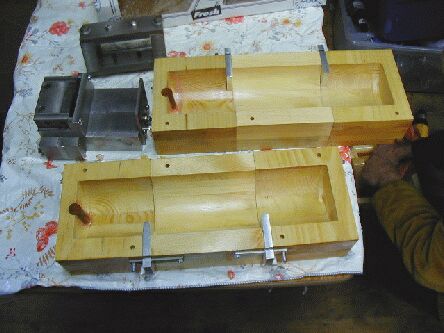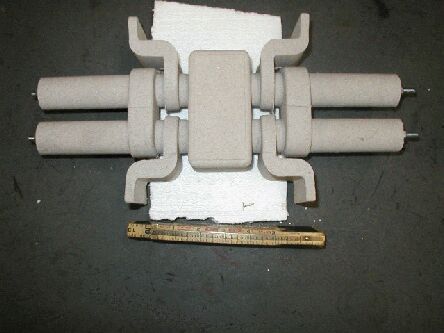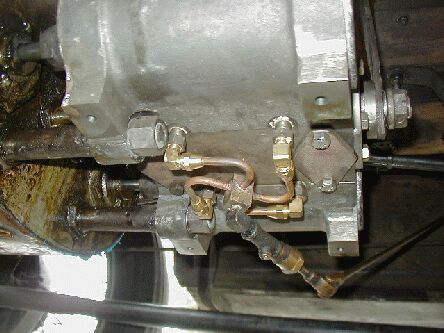
The Nergaard-SACA-NE Piston Vavled Stanley Cylinder Block Project
As a result of several catastrophic engine failures in the last two years, my old cylinder block has been reduced to a condition where even I don't think it is recoverable. Therefor, I decided to see whether there was sufficient interest in producing a series of piston valved blocks for the Stanley type seven, twenty horsepower, engine to justify the costs of making patterns for a new design. This engine was in production from 1908 until 1925.
I based the design of the new block on my old one, which is the subject of SACA drawing set #205. I proposed several changes, which were small enough to be understood without the need to make new drawings. These are, first, making the valve bores go right through the block instead of being dead ended as in the old one. This meant removing the boss and tapped hole intended for the hangar strap stud. Second, the exhaust chests were enlarged and modified so the exhaust manifold could be fitted to either the top of the bottom of the block. This should result in very free exhaust flow as well as giving the user a choice of exhaust pipe routing. Finally, the block is designed so machininig the ends consisted primarily of planing them flat, a job which could be done equally well with several machine tools. These changes were made partly to improve the performance of the engine, but mostly to simplify the patterns and reduce the cost of machining the resulting castings.
I gave a brief description of the proposed project at the December chapter meeting, with encouraging results. I then contacted several other Stanley owners in the area, with equally encouraging responses. An E-mail message to Pat Farrell, which he evidently forwarded to the nation as a whole, produced further encouragement. This encouragement took the form of orders for several blocks, and deposits sent for most of them!
At this point, I committed my self to proceed, wrote and submitted an advertisement to several steam car publications, and got estimates from two pattern makers. Tom Stoecker, fellow chapter member and already involved in the replica Doble project, was the low, and enthusiastic, bidder and was given the job before the end of the year.
A set of drawings of his proposed patterns was sent to me and Dick Olivier early in January and the few necessary revisions made and accepted soon after. Tom's completed patterns were displayed at the February chapter meeting.

Cylinder Core Box

Cope Pattern
The next step was to locate a suitable foundry, which meant one that will take on a short run of relatively complicated castings on short notice. The Fairmont Foundry in Woonsocket was selected, and the first run of four castings was delivered on the first of March.

Cores for Valves and Cylinder Ports

Drags with Cores in Place, One Complete Mold in Background
Tom Stoecker has undertaken the job of machining this first batch of blocks as a subcontractor, with a view to being able to offer this service to those customers who want it. The delivery of the first machined block was made on the 24th of March. Valve bore sleeves and special "valve type" piston rings have been ordered from outside suppliers, and delivered. Two sleeves have had the required ports cut and have been pressed into the block.
Drawings for a "kit" supplying all the parts needed for using the piston valve block are being prepared. Sketches in "Nergaardian scribble" are being redrawn in AutoCAD by Tom Stoecker. The parts include valves, valve stems, sleeves, valve stem stuffing boxes, engine hanger stud, exhaust manifold, and snifter valves, which are used as cylinder drains. I made some of the parts needed to test the new block. These include the valves, hanger stud and exhaust manifold. I reused the valve stems and stuffing boxes.

Kit of Parts, Machined Block in Background
I had received orders, with deposits, for eighteen blocks. Six of these deposits have come from chapter members. This was before the advertisement appeared in print!
The ad' has now been printed in the SACA Bulletin and the Stanley Museum Quarterly, and has resulted in two further enqueries. One of these has been followed up by an order for two blocks, with a deposit. The same mail delivery that brought that included the latest issue of the British "Steam Car" magazine, which has printed my advertisement, but without 'phone number or E-mail address. It remains to be seen what response that generates.
The test engine was assembled, installed in my car and driven to the April meet of the NorthEast chapter.

Assembled Engine

Installed Cylinder Block

Bottom View of Engine in Car, Showing Cylinder Drain Valves.
However, there were some apparent problems and driving tests were canceled until they could be resolved. The engine has been removed from the car and examined. The problems have nothing whatever to do with the new block. The serious problem was a bad main bearing on the old crankshaft. The remaining problem was caused by poorly made snifter valves, which jammed in a way to prevent draining the cylinders. New valves have been made. In the process of replacing these valves, it was found that they had been located so it was impossible to service them without removing the block from the engine. This can be corrected by changing their location slightly and the appropriate changes in the drawings for the machinist will be made.
The car has since been driven about four hundred miles but no valid figures for fuel and water consumption have been obtained due to other problems with the car. The engine performs well, the car wants to GO!
The first "production" run of nine blocks has been cast and a second run of ten is expected momentarily.

"Production" Blocks, "Test" Car in Background
David K. Nergaard, 16 April 2002, revised 18 June, 2002.
Back to Papers